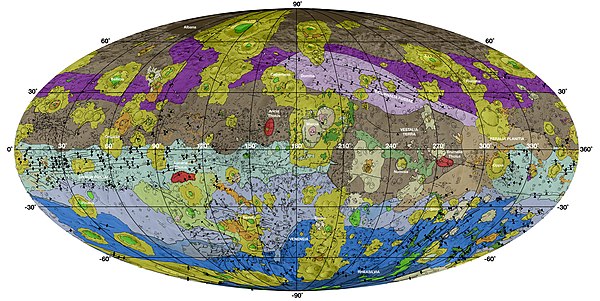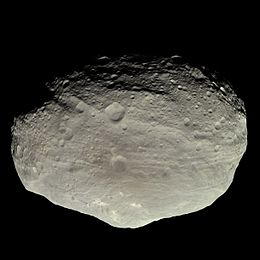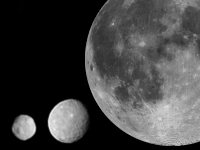Vesta
(Vesta: Minor Planet,Asteroid,Internal Structure,Atmosphere,Exploration)
Vesta, minor-planet designation 4 Vesta, is one of the
largest objects in the asteroid belt, with a mean diameter of 525 kilometres
(326 mi). It was discovered by the German astronomer Heinrich Wilhelm Olbers on
29 March 1807 and is named after Vesta, the virgin goddess of home and hearth
from Roman mythology.
Vesta is the second-most-massive and second-largest body in
the asteroid belt after the dwarf planet Ceres, and it contributes an estimated
9% of the mass of the asteroid belt. It is slightly larger than Pallas, though
significantly more massive. Vesta is the last remaining rocky protoplanet (with
a differentiated interior) of the kind that formed the terrestrial planets.
Numerous fragments of Vesta were ejected by collisions one and two billion
years ago that left two enormous craters occupying much of Vesta's southern
hemisphere. Debris from these events has fallen to Earth as
howardite–eucrite–diogenite (HED) meteorites, which have been a rich source of
information about Vesta.
Vesta is the brightest asteroid visible from Earth. Its maximum
distance from the Sun is slightly greater than the minimum distance of Ceres
from the Sun, though its orbit lies entirely within that of Ceres.
NASA's Dawn spacecraft entered orbit around Vesta on 16 July
2011 for a one-year exploration and left orbit on 5 September 2012 en route to
its final destination, Ceres. Researchers continue to examine data collected by
Dawn for additional insights into the formation and history of Vesta.
Discovery
Heinrich Olbers discovered Pallas in 1802, the year after
the discovery of Ceres. He proposed that the two objects were the remnants of a
destroyed planet. He sent a letter with his proposal to the English astronomer
William Herschel, suggesting that a search near the locations where the orbits
of Ceres and Pallas intersected might reveal more fragments. These orbital
intersections were located in the constellations of Cetus and Virgo. Olbers
commenced his search in 1802, and on 29 March 1807 he discovered Vesta in the
constellation Virgo—a coincidence, because Ceres, Pallas, and Vesta are not
fragments of a larger body. Because the asteroid Juno had been discovered in
1804, this made Vesta the fourth object to be identified in the region that is
now known as the asteroid belt. The discovery was announced in a letter
addressed to German astronomer Johann H. Schröter dated 31 March. Because
Olbers already had credit for discovering a planet (Pallas; at the time, the
asteroids were considered to be planets), he gave the honor of naming his new
discovery to German mathematician Carl Friedrich Gauss, whose orbital
calculations had enabled astronomers to confirm the existence of Ceres, the
first asteroid, and who had computed the orbit of the new planet in the
remarkably short time of 10 hours. Gauss decided on the Roman virgin goddess of
home and hearth, Vesta.
Orbit
Vesta orbits the Sun between Mars and Jupiter, within the
asteroid belt, with a period of 3.6 Earth years, specifically in the inner
asteroid belt, interior to the Kirkwood gap at 2.50 AU. Its orbit is moderately
inclined (i = 7.1°, compared to 7° for Mercury and 17° for Pluto) and
moderately eccentric (e = 0.09, about the same as for Mars).
True orbital resonances between asteroids are considered
unlikely; due to their small masses relative to their large separations, such
relationships should be very rare. Nevertheless, Vesta is able to capture other
asteroids into temporary 1:1 resonant orbital relationships (for periods up to
2 million years or more); about forty such objects have been identified.
Decameter-sized objects detected in the vicinity of Vesta by Dawn may be such
quasi-satellites rather than proper satellites.
Exploration
In 1981, a proposal for an asteroid mission was submitted to
the European Space Agency (ESA). Named the Asteroidal Gravity Optical and Radar
Analysis (AGORA), this spacecraft was to launch some time in 1990–1994 and
perform two flybys of large asteroids. The preferred target for this mission
was Vesta. AGORA would reach the asteroid belt either by a gravitational slingshot
trajectory past Mars or by means of a small ion engine. However, the proposal
was refused by the ESA. A joint NASA–ESA asteroid mission was then drawn up for
a Multiple Asteroid Orbiter with Solar Electric Propulsion (MAOSEP), with one
of the mission profiles including an orbit of Vesta. NASA indicated they were
not interested in an asteroid mission. Instead, the ESA set up a technological
study of a spacecraft with an ion drive. Other missions to the asteroid belt
were proposed in the 1980s by France, Germany, Italy and the United States, but
none were approved. Exploration of Vesta by fly-by and impacting penetrator was
the second main target of the first plan of the multi-aimed Soviet Vesta
mission, developed in cooperation with European countries for realisation in
1991–1994 but canceled due to the Soviet Union disbanding.
In the early 1990s, NASA initiated the Discovery Program,
which was intended to be a series of low-cost scientific missions. In 1996, the
program's study team recommended a mission to explore the asteroid belt using a
spacecraft with an ion engine as a high priority. Funding for this program
remained problematic for several years, but by 2004 the Dawn vehicle had passed
its critical design review and construction proceeded.
It launched on 27 September 2007 as the first space mission
to Vesta. On 3 May 2011, Dawn acquired its first targeting image 1.2 million
kilometers from Vesta. On 16 July 2011, NASA confirmed that it received
telemetry from Dawn indicating that the spacecraft successfully entered Vesta's
orbit. It was scheduled to orbit Vesta for one year, until July 2012. Dawn's
arrival coincided with late summer in the southern hemisphere of Vesta, with
the large crater at Vesta's south pole (Rheasilvia) in sunlight. Because a
season on Vesta lasts eleven months, the northern hemisphere, including
anticipated compression fractures opposite the crater, would become visible to
Dawn's cameras before it left orbit. Dawn left orbit around Vesta on 4
September 2012 11:26 p.m. PDT to travel to Ceres.
NASA/DLR released imagery and summary information from a
survey orbit, two high-altitude orbits (60–70 m/pixel) and a low-altitude
mapping orbit (20 m/pixel), including digital terrain models, videos and
atlases. Scientists also used Dawn to calculate Vesta's precise mass and
gravity field. The subsequent determination of the J2 component yielded a core
diameter estimate of about 220 km assuming a crustal density similar to that of
the HED.
Physical characteristics
Vesta is the second-most-massive body in the asteroid belt,
though only 28% as massive as Ceres. Vesta's density is lower than that of the
four terrestrial planets, but higher than that of most asteroids and all of the
moons in the Solar System except Io. Vesta's surface area is about the same as
that of Pakistan (about 800,000 square kilometers). It has a Geologic map of Vesta
 differentiated
interior. Vesta is only slightly larger (525.4±0.2 km) than 2 Pallas (512±3 km)
in volume, but is about 25% more massive.
differentiated
interior. Vesta is only slightly larger (525.4±0.2 km) than 2 Pallas (512±3 km)
in volume, but is about 25% more massive.
 differentiated
interior. Vesta is only slightly larger (525.4±0.2 km) than 2 Pallas (512±3 km)
in volume, but is about 25% more massive.
differentiated
interior. Vesta is only slightly larger (525.4±0.2 km) than 2 Pallas (512±3 km)
in volume, but is about 25% more massive.
Vesta's shape is close to a gravitationally relaxed oblate
spheroid, but the large concavity and protrusion at the southern pole (see
'Surface features' below) combined with a mass less than 5×1020 kg precluded
Vesta from automatically being considered a dwarf planet under International
Astronomical Union (IAU) Resolution XXVI 5. A 2012 analysis of Vesta's shape
and gravity field using data gathered by the Dawn spacecraft has shown that
Vesta is currently not in hydrostatic equilibrium.
Temperatures on the surface have been estimated to lie
between about −20 °C with the Sun overhead, dropping to about −190 °C at the
winter pole. Typical daytime and nighttime temperatures are −60 °C and −130 °C
respectively. This estimate is for 6 May 1996, very close to perihelion,
although details vary somewhat with the seasons.










0 comments:
Post a Comment